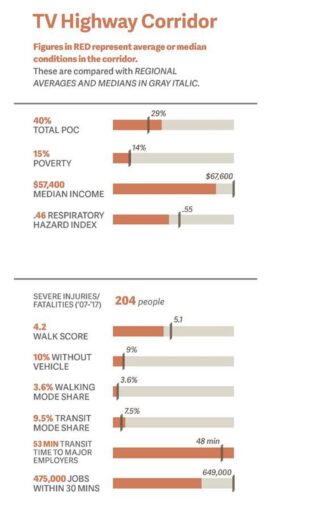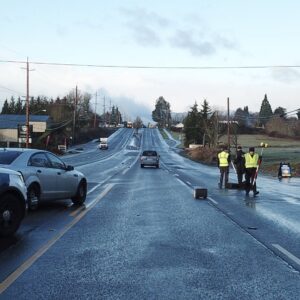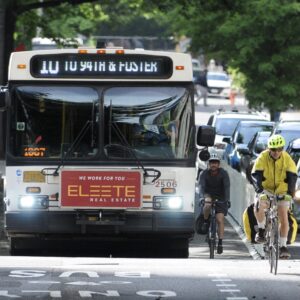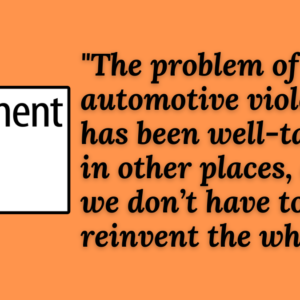
TriMet and Metro have teamed up on a $1 million project that aims to finally deliver major transit and community upgrades along Tualatin-Valley Highway, or what we’ve previously referred to as the “aorta of Washington County.”
“[Line 57] really is the backbone for tens of thousands of people that live alongside it.”
— Juan Carlos Gonzalez, Metro councilor
And the work cannot happen fast enough. We’ve reported on many deaths on TV Highway over the years. And just this week, another person was killed by a driver when they were hit while trying to cross SW 198th.
But a focus just on deaths ignores the everyday toll of an intimidating, dangerous road that holds many people hostage and prevents them from reaching not just their life and work destinations, but their own personal potential. A witness who saw Tuesday’s fatal collision told a KATU-TV reporter, “I don’t ride my bike around anymore because the traffic is so bad, and people don’t pay attention.”
Now, thanks to an $850,000 grant from the Federal Transit Administration’s Helping Obtain Prosperity for Everyone (HOPE) program, Metro and regional partners have kicked off an effort to make the road safer and more useful to more people. They will identify which type of bus rapid transit (BRT) would work best on TV-Hwy and come up with a plan to make sure future changes don’t have negative impacts on the people who currently live and travel in the area.
The grant was awarded in late 2020, but this morning, Metro’s Joint Policy Advisory Committee on Transportation (JPACT) was given its first briefing and update on the project.
“There’s a good good reason we’re focused on TV Highway,” said Metro project manager Eryn Kehe at JPACT this morning. “Because of the physical needs of the roadway itself, the transit needs in that area, and the number of people who depend on transit for their transportation.”
Advertisement

Despite relatively low density in the area, TriMet’s Line 57, which currently serves TV Highway, is the 10th busiest in the region. Of the 180,000 people who live in the area, nearly 72,000 (40%) identify as people of color. Over half of the 30,000 jobs in the area pay less than $40,000 per year and 40% of the population are well below the poverty line. The riders on this line depend on it so much, TriMet says it was one of the most resilient in terms of ridership throughout the pandemic.
“[Line 57] really is the backbone for tens of thousands of people that live alongside it,” said Metro Councilor Juan Carlos Gonzalez at the meeting. But it’s very weak backbone.
Cornelius Mayor Jeff Dalin described using transit on TV Highway as, “A slow slog.” “It’s 15 minutes from Cornelius to Hillsboro in a personal vehicle and it’s an hour on the on the bus.”
Metro plans to come up with a design concept that would make bus service faster and more appealing, a feasibility analysis of electric bus use, and a separate (but related) plan will figure out how to make sure these major investments and changes happen without displacing existing residents. Metro’s Kehe said the goal of their “equitable development strategy” is to allow people to stay in the area and benefit from the improvements that are coming. And they plan to pick up where Metro and TriMet left off on the Get Moving 2020 ballot measure concept that has already been developed for TV Highway.
Given the considerable political urgency and funding that has lined up around this project, there’s a sense that once this planning process is complete one year from now, TV Highway will be perfectly positioned to compete for a major federal grant.
What could this project hold for bikeway improvements? In 2014 The Street Trust pushed for a major protected bikeway along the corridor, so there’s some planning to start with. But since this planning grant is from the FTA, there’s not likely to be much talk of bike infrastructure. That being said, the highway currently has bike lanes and there’s plenty of width to work with, so any project that gets funded should include high-quality, physically-protected space for cycling and other micromobility vehicles.
“What really excites me about the project is the comprehensive look at the corridor and in helping it to grow up as the rest of the west side has grown up,” said Metro’s Juan Carlos Gonzalez, who has been an ardent supporter of investing in it. “And that’s transportation, that’s transit, that’s also land use, that’s economic development and supporting our small businesses. And helping it become the 21st century corridor that the West Side deserves.”
The project’s steering committee met for the first time this week and Metro says a decision on a Locally Preferred Alternative (LPA) will be ready in June 2023.







Thanks for reading.
BikePortland has served this community with independent community journalism since 2005. We rely on subscriptions from readers like you to survive. Your financial support is vital in keeping this valuable resource alive and well.
Please subscribe today to strengthen and expand our work.
After the K-Mart shopping area on TV Highway/Canyon at Murray Blvd became housing of boring designs, why did ODOT not add a bus-only lane at least for east-bound bus 57?
The statement by the mayor of Cornelius needs a fact check. There are no places in Cornelius and near TV highway in Hillsboro which are 15 minutes apart by car, but 60 minutes by bus.
It takes 12 minutes on the bus from the stop near Cornelius City Hall to the Civic Center of Hillsboro. With 6 minutes walk time it’s a 18 minute trip minimum. Trimet bus 57 runs every 15 mintues, so max trip time is 32 minutes if you just missed the bus, during most of the day, average time is 24 minutes if you go at a random time. Trimet trip planner: https://tinyurl.com/3ckr5jn2
Driving that distance would take 8 minute to drive without traffic (but up to 12 min at busy times): https://www.openstreetmap.org/directions?engine=fossgis_osrm_car&route=45.5217%2C-123.0548%3B45.5223%2C-122.9894
So let’s go from the far west limit of Cornelius (the Walmart) to the far east part of Hillsboro on TV highway (Fred Meyer on Century Blvd) – this is 8.3 miles by car, so you might make it at 15 minute at 6am or 10 pm with no traffic. The bus trip is only 33 minutes on Trimet, plus 5 minutes walking.
Transit is always going to be slower than driving, unless transit gets it’s own lanes or tracks, but it’s not as bad as the Mayor thinks.
15 vs 60 minutes was probably meant as hyperbole, but its not that far from the truth. When I lived there for several years, the 57 was never on schedule, and it often took 30+ minutes between Hillsboro and Cornelius. The high number of riders getting on and off at every stop can not be overstated. A lot of traffic lights are on very long timers and only stay green for a few seconds. In rush hour there is a stop sign that often takes more than 10 minutes to cross a 3 lane, 1 way street. Entering from a 1 lane street, the bus is large and needs more than 1 lane on the road it is turning onto, which has an indefinetely steady stream of cars. Sometimes the bus had to wait until the next scheduled bus rolled by and made a gap, which means at least 1 of the buses is late (often both, because the other bus had to do the same thing). Thats not the worst stop sign in town either, as a former driver I was stuck at one for 20 minutes once, until someone unnecessarily yielded to save me and almost got themselves rear ended. In that spot I have seen people driving reverse or even abandoning their vehicle to escape the stop sign.
There are other reasons the 57 bus is slower than you would expect, but the main reason cars are so much faster is because of the extreme level of priority they were given in street design. Hillsboro was originally designed as a low density high speed area. The complete circuits of 1 way streets with very few red lights are popular for street racing, despite the high police presence. Parts of town dont have any sidewalks either. I did enjoy biking there whenever I didnt have to cross the river of cars, the side streets were relatively peaceful without much non-local traffic, though this might have changed in the few years since I moved away. I expect it is changing rapidly as people move there who were priced out of Beaverton. I assume the Mayor lives there now, and I assume he is thinking to the future, where 60+ minute bus rides from Hillsboro to Cornelius will indeed become common unless things are improved with capacity in mind.